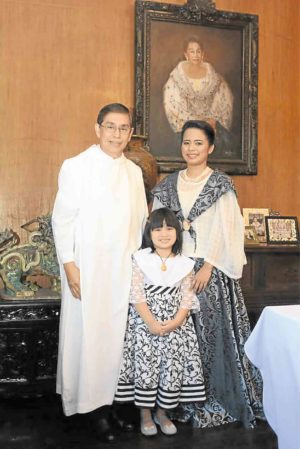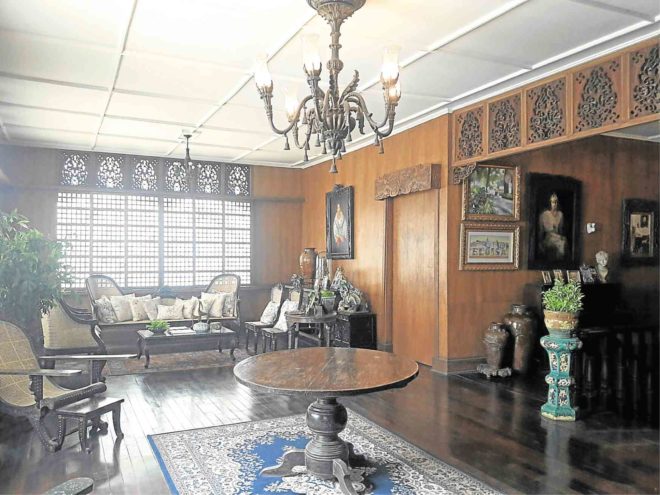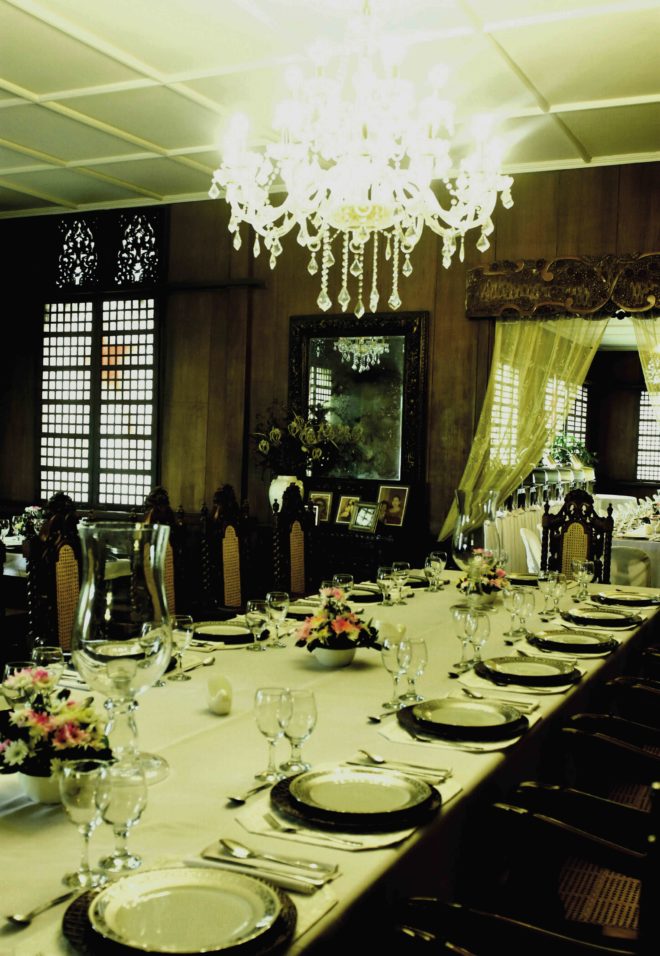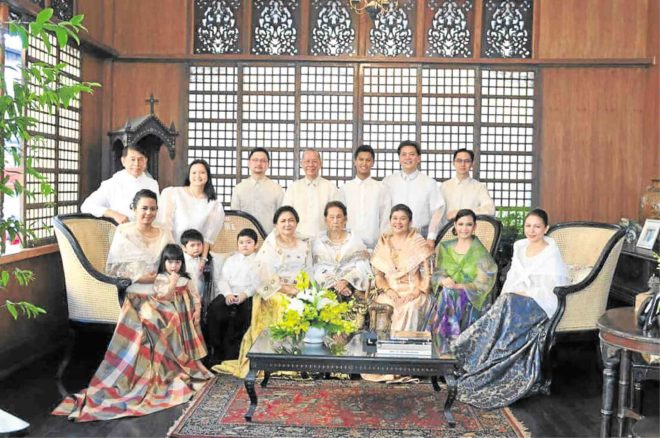

Like a movie set, Bale Matua in San Fernando, Pampanga, comes alive as the old furniture and décor are removed from boxes and dusted off for an event.
Bale Matua—Kapampangan for “ancestral house”—was built in the early 20th century and belongs to the Hizon-Paras family. It was gutted by fire in the 1950s and rebuilt.
Full of sentimental value, it has become a gathering place for relatives, a venue of cultural and religious events, or simply a hearth.
“The house is full of memories. I’m grateful I had a beautiful childhood, the foundation of which helped me in my religious life,” said Dom Martin Hizon Gomez, the Benedictine monk from the Monastery of Transfiguration in Bukidnon.
Born Edgardo Ramon Hizon Gomez, he was the fashion designer known as Gang Gomez before he entered the religious life.
The Benedictines are leaders of the liturgical movement and promoters of the Catholic Church’s cultural patrimony, so it came as no surprise that Dom Martin wrote the book, “Worship and Weave: Towards Filipino Liturgical Vestments.”
He’s working on his second book, “Hizon: Portrait of a Kapampangan Clan,” which will discuss his mother’s lineage. It’s a family history linked to Gomez’s research on Pampanga’s heritage and culture.
Bale Matua is a typical bahay na bato (stone house). Its top floor has balustrades, ventanillas or small windows under the window sash, and sliding windows with capiz panes.
Above the windows are intricate fretwork. The upper story, made of wood, is erected on top of the ground floor made of solid stone blocks and posts.
Like every ancestral home, the house has a chapel. A mesa altar displays valuable religious ivory icons in antique virina. Clad in gold-embroidered vestment, the image of Saint Augustine, the patron saint of Hizon’s Hacienda San Agustin, is kept in a vintage aparador.
Fire
In 1950, a fire gutted the house in the middle of the night. At the time, Dom Martin’s grandfather, Don Ramon Hizon, a sugar haciendero, was in the hospital. His children kept the sad news from him and tried to keep him confined in the hospital for months during the renovation.
However, the patriarch grew restless and insisted on coming home. He finally learned that the house had burned down due to faulty wiring.

Although it was restored to its original architecture, the house was built with a setback to shield it from street noise. The primera sala, or foyer, in the original design, was done away with.
Gomez’s family shared the house with his unmarried aunt, Lourdes, and the family of his uncle, Rodolfo Hizon, who served as mayor for 30 years.
Gomez grew up with the sight of people waiting in the azotea for appointments with his uncle.
More than the queues of townsfolk, the house had also seen the visits of past Philippine Presidents Ramon Magsaysay and Diosdado Macapagal, and a young Benigno Aquino Jr.
Don Ramon, a patron of education and seminarians, welcomed the clergy and the religious to his home. While Gomez was away in college in Manila, his room in Bale Matua, furnished with his grandfather’s heirloom four-poster bed, would be used by Benedictine nuns who visited their benefactors in Pampanga.
Gomez’s relatives were drawn to the religious life: An aunt joined the Pink Sisters; a cousin went to the Salesians; a cousin became a Jesuit and a bishop; another aunt, a Carmelite prioress; a third aunt, a Good Shepherd nun; and still another cousin, a Benedictine nun.
The Kapampangan were tightly knit. Relatives would drop by the ancestral home after attending Mass. During Lent, the Pabasa (the tradition of singing the Passion of Christ) was held at home as relatives recited the prayers in Kapampangan.

Even today, the cousins meet up at Bale Matua on Good Friday after accompanying in the procession the carroza of San Pedro, one of the icons belonging to the family.
Gomez’s mother, Eloisa Hizon Gomez, took over Bale Matua, following the Kapampangan tradition that the youngest in the family inherits the house.
Family recipes
In 1995, typhoon “Mameng” struck and let loose floodwaters and mudflow from Mount Pinatubo. Lahar destroyed a number of barangays.
Gomez’s brother-in-law, Jason, husband of his sister Erlie, had to rescue Gomez’s parents using a rubber boat. Since the boat went against the current, it made it to the Hizon house, which was less than a kilometer away from where Jason was, after seven hours.
The children told their parents it was too dangerous to return to the ancestral home. They moved to Barrio San Agustin, site of the old sugar hacienda.
Bale Matua remained locked up for seven years.
Over time, its ground floor was turned into a fishpond because San Fernando was like a catch basin. Water flowed into it from other towns. The ground floor attracted fish so that it became a pond of fingerlings.
Renovated
Gomez and his relatives decided to restore the house, in stages, to its former glory. In 2012, a party was held on the second floor of Bale Matua, and the visitors took the side stairway leading to the azotea.
The house was formally reopened on Jan. 2, 2014—the birthday of Gomez’s mother Eloisa.
For the occasion, family members and close friends dressed up in Filipiniana—the women in baro’t saya.
The hosts dug up their heirloom Kapampangan recipes— bringhe or Kapampangan paella with Indian-infused turmeric; asadong lengua, lumpiang ubod and ukoy.
The Hizons’ signature iking matua was oxtail, cooked for hours and drenched in a sauce of bell pepper, onions, garlic, olives, carrots and special chorizo Pamplona.

Likewise there were traditional desserts such as dulce prenda; empanadita stuffed with sweet kundol or winter melon, shaped like a medallion; plantanilla, delicate crepe filled with carabao milk custard; and San Nicolas cookies, intricately molded from an image of St. Nicholas.
In recent years, the house comes alive on special occasions: Eloisa’s wake in 2014; a prenuptial dinner for a niece; the celebration of a wedding engagement of a relative; the 70th birthday of a cousin; and the children’s party of a grandniece.
On Holy Week, the carroza of San Pedro is wheeled out of the bodega of the old hacienda.
The silong, which used to be a stockroom, has been converted into an events venue where the family holds Mass, among other gatherings. It was also the venue of an exhibit, “Recuerdos,” a collection of 25 oil paintings of family photographs by Malaybalay’s foremost painter, Vicente Barretto.
Oil portraits of Don Ramon and his wife, Doña Maria Paras de Hizon, and Rodolfo Hizon are now displayed in the formal dining room.
In the restored primera sala, an oil portrait of Eloisa greets visitors. The portrait of Eloisa’s sister, Carnival Queen 1933 Corazon Hizon Dizon, hangs above the piano.
The life-size statue of the patron San Fernando stands guard in the house, carved by ecclesiastical sculptor Wilfredo Layug. An antique Virgen de los Remedios is in the chapel on the second floor.
The Bambino di Aracoeli, an icon of the Infant Jesus, to whom Gomez has a special devotion, joins the annual procession of the Congregacion del Santisimo Nombre del Niño Jesus in Manila. —CONTRIBUTED









































